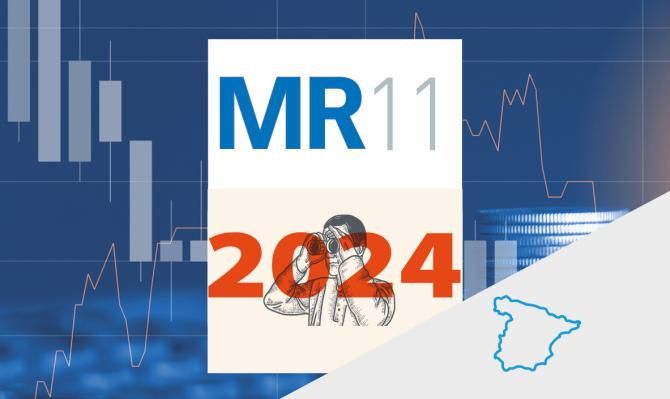The Spanish economy feels the effects of the weak external environment

After a better-than-expected first half of the year, the flash estimate for Q3 GDP confirms the weakening of the economy that was already anticipated by the various economic indicators. The slowdown in the second half of the year is mainly due to the cooling of economic activity in the euro area and the impact of the interest rate hikes. On the upside, the economy’s capacity to generate employment in a less favourable environment continues to stand out.
GDP grew 0.3% quarter-on-quarter in Q3 2023 (1.8% year-on-year), which is 10 percentage points less than the previous quarter and the lowest growth rate since Q1 2022, although the Spanish economy has performed better than the large European economies. Domestic demand has been taking over from foreign demand as the economy’s driver of growth. This is especially the case for private consumption which, supported by the containment of inflation and the strength of the labour market, has finally recovered pre-pandemic levels. In contrast, foreign demand deducted 0.4 pps from quarter-on-quarter GDP growth, as exports fell more sharply than imports.

The GDP figure for Q3 2023 is in line with our forecast scenario, meaning that the risks surrounding our growth forecast for 2023 as a whole, of 2.4%, remain balanced. For 2024, we estimate that the pace of growth of the Spanish economy will slow to 1.4%, affected by the impact of the lower buoyancy of our main trading partners and the recent rebound in the oil price, albeit with a gradual improvement over the course of the year as the external environment and confidence among economic agents improve and as the NGEU funds are executed.
In October, the Purchasing Managers’ Index (PMI) for the manufacturing sector fell 2.6 points to 45.1 points, meaning that it has been in contractionary territory (below 50 points) for seven consecutive month now. The PMI for the services sector, meanwhile, remains in expansionary territory, specifically at 51.1 points. As for the Harmonised Business Confidence Index (HBCI) developed by the National Statistics Institute, it recorded its first decline in the past year, specifically of –2.0% quarter- on-quarter, reflecting the deterioration in the expectations of business leaders regarding their firms’ progress. In particular, the percentage of optimists fell (19.2% of the total, 3 points less than in the previous quarter), while the proportion of pessimists increased (by 1.9 points to 18.9%), placing the balance (the difference between these two percentages) at 0.3 (previously 5.2).

In the period July-September, 29 million foreign tourists arrived in our country, and they spent 38.6 billion euros, representing growths of 12.9% and 19.4% year-on-year, respectively. Compared to pre-pandemic levels, the number of tourist arrivals exceeds the 2019 figure by 0.7%, while the expenditure figure is 16.0% higher. The number of overnight stays in tourist accommodation establishment was 0.5% higher than in the summer of 2019: international tourism continued to improve and reached just 1.5% below the pre-pandemic number of overnight stays, while in the case of domestic tourism the figure was 3.7% higher.

The data from the LFS for Q3 2023 were better than expected due to a significant increase in the number of people in employment, as well as in the total labour force. Employment increased by 209,100 people, beating both last year’s figure (+77,700) and the Q3 average for the period 2014-2019 (+174,800). With this statistics, the employment rate (the number of people in employment as a percentage of the population aged 20 to 64) has reached an all-time high, standing at 71.4%. The improvement in this rate is largely due to the greater incorporation of women into the labour market and the higher retirement age, and it is essential for improving the economy’s growth potential, as it represents an increase in the degree of utilisation of the available labour resources.
As for unemployment, it increased by 92,700 people in the quarter, nudging the unemployment rate up by 20 percentage points to 11.8%. This increase contrasts with the decline that usually occurs in Q3 (–185,000 on average in the period 2014-2019) and is attributable to the exceptional increase in the overall labour force (301,900, the second largest increase in the series in a third quarter, only surpassed by the anomalous figure recorded in 2020). This increase in the labour force, which has brought the total to a record high (24.12 million people), was mainly due to the increase in the foreign population, which grew by 144,200 people. The Spanish population in the labour force, meanwhile, grew by 93,800 people, and those with dual nationality by 63,800. Since Q1 2018, which is when the total labour force began to grow, only abruptly interrupted by the pandemic, the labour force has recorded cumulative growth of 1.45 million people, mostly foreign nationals (825,800 people vs. 189,600 Spaniards and 435,400 people with dual nationality).

The Social Security affiliation data for October show an increase in employment of 92,861 people, the weakest October figure since 2015. In seasonally adjusted terms, employment recorded an increase of 5,077 registered workers, below the monthly average for Q3 (15,651). Looking ahead to 2024, we expect the rate of job creation to remain positive but relatively contained, with an increase of +1.4% compared to 2023, which should allow the unemployment rate to be reduced to 11.8% on average for the year.

Inflation is slowing and stabilised in October at 3.5%, largely thanks to the fall in fuel prices. The core inflation rate (which excludes energy and unprocessed food) fell sharply to 5.2% (5.8% in September), the lowest level since May 2022. This statistic, together with the downward trend of recent months, suggests that the underlying inflationary pressures are gradually moderating.
For 2024, the headline inflation rate is likely to remain at similar figures to this year (3.6% annual average) if the anti-inflation measures are withdrawn. However, we do expect a moderation in core inflation (which excludes food and energy) from 4.6% in 2023 to 3.0% in 2024.
